Unconventional oil and gas: Economic Impact Assessment and scenario development of unconventional oil and gas in Scotland
Research into Economic Impact Assessment and scenario development of unconventional oil and gas in Scotland.
4 Scenarios for UOG development in Scotland
4.1 Coverage
Three sources of UOG are considered as part of this study, namely:
- Gas extracted from onshore shale sources using hydraulic fracturing;
- Associated liquids extracted from onshore shale sources using hydraulic fracturing; and
- Coal bed methane.
Based on discussions with industry, we assume that the focus for developers in Scotland would be shale gas development with liquids as an associated product, should exploration be successful. The evidence base on coal bed methane is limited, especially in the Scottish context. Resources estimates for CBM are uncertain [21] and CBM is thought to be located in the same geographical areas as shale gas and associated liquids. Based on surface access, geology, development costs and estimated well recovery rates, CBM is currently unlikely to be a major product in Scotland. As such, we have assumed that only two CBM pads would be developed.
4.2 The scenarios considered
There is considerable uncertainty regarding a wide range of factors in the Economic Impact Assessment of Scottish UOG. Following workshops with stakeholders, UKOOG provided us with some of their members' views on UOG development in Scotland. The scenarios developed for the purposes of this study are therefore based on UKOOG's submission as well as wider information gathered through literature review - this includes the IoD report on shale gas (2013) and the EY report on shale gas and its supply chain (2014). KPMG discussed the scenarios with UKOOG and took on board their comments. As a result, the scenarios reflect a range of outcomes in the development of UOG in Scotland. Three production scenarios in which exploration is successful were assessed:
- Central scenario - based on midpoint estimates of potential production;
- High scenario - in which significant development occurs in the next decade or so [22] ; and
- Low scenario - in which development is initially slow and does not grow significantly, for example there is a low level of production [23] .
Given the uncertainty regarding the level of shale resources in place, we also consider the costs of exploration should no development of UOG resources take place. In this alternative case, no economic benefits would arise and operators involved in exploration would incur a loss.
All of our scenarios are modelled up to 2062 to allow consideration the full lifecycle of pads through planning and licensing, exploration, development, production and decommissioning and aftercare. We have taken a long-term view in this study to evaluate the full economic lifecycle of the industry and to consider the implication of decommissioning and aftercare costs. Regarding Scottish demand for gas, we assumed that total demand [24] remains unchanged over the studied period.
Our UOG development scenarios are based on the potential pads operators could develop in the Midland Valley of Scotland. The Midland Valley is a highly populated area of Scotland, hence there are limits to the available surface that can be used for UOG resource development (see Appendix C for further details). Our scenarios are based on the potential developable area in the Midland Valley and is based on a different number of pads for each scenario. Multi-lateral wells drilled from a single 'mother bore' are increasingly used in the US but it is unclear at present whether this approach would be successful in Scotland due to complex geology and thinner shales ( BGS, 2014). Industry estimates suggest that drilling 6 to 12 mother bores per pad in a smaller area or between 15 to 30 mother bores per pad in a larger area is a reasonable estimate. Industry has also suggested in Scotland it is reasonable to assume only one production or lateral well per mother bore. For ease of reading, we refer to a mother bore with one lateral well as a 'well'.
Well recovery data varies with local geology and/or well location, i.e. well recovery can be different from one shale area to another as highlighted by Ozkan & Duman (2015) in their report on the economic evaluation of Marcellus and Utica shale plays. At the lower end a well could produce less than 3 bcf over its lifetime while a high end estimate could be over 5 bcf/well over lifetime. Because of the level of uncertainty around UOG resources in Scotland and the proportion of these that could be recovered, we have been cautious in our approach to well recovery. This is reflected in our assumption that a well could produce c3.16 bcf over its lifetime.
4.3 Resource development
4.3.1 Central scenario
The Central scenario is our potential midpoint scenario regarding the development of shale gas and associated liquids in Scotland. We assume a three [25] year period for planning and licensing (2018-2021). We assume that exploration lasts two years (2022-2023) and the development of the pad infrastructure is completed within a year (2023-2024). We assume that the first flow of product is in 2024 with peak production reached in 2036. It is assumed that a pad has a 15-year lifespan, i.e. for a pad built in 2023 production ceases in 2038, and that decommissioning can take up to three years, i.e. from 2039 to 2041-2042 for a pad built in 2023.
Shale gas
This scenario is based on the development of 20 pads of 15 wells each built over 11 years starting in 2023-2024. Shale gas volumes are produced until c2048. At industry level, peak production is reached in 2036 with a total annual output of approximately 76 bcf. The cumulative production of a single pad over its lifespan is 47.3 bcf, which represents an average of 3.16 bcf per annum.
Associated liquids
Associated liquids is produced as an associated product to shale gas and it is assumed that:
- It has the same production profile as shale gas;
- 75% of 'existing' shale gas pads also produce associated liquids, i.e. 15 pads; and
- Associated liquids are produced over a period to 2046.
Industry-wide peak production is reached in 2036 with a total annual output of approximately 1.5 MMBOE. The cumulative production of a pad over its lifespan is 1.2 MMBOE, which represents an average of 0.08 MMBOE per annum over 15 years.
Coal bed methane
We assume that two CBM pads are developed over two years. Each pad has 15 wells and produce 13.1 bcf over 12 years - an average production of 1.1 bcf per annum. We assume that all CBM wells are drilled in the development phase. Production commences in 2024 and lasts until 2036. However, at current gas prices, the development of two coal bed methane pads and associated production volumes would not generate high enough revenues to justify the investment. If CBM can be economically developed it will have a positive GVA contribution to the Scottish economy as demonstrated in Section 5.
4.3.2 High scenario
The High scenario models a positive case for both shale gas and associated liquids. For a pad starting planning and licensing in 2018, we assume that this could take up to two years and is completed by 2019-2020 - this is a shorter lead time compared to our Central scenario based on shorter planning horizon. It is assumed that exploration lasts two years and the development of the pad infrastructure is completed by 2022. We assume that the first flow of products is in 2023 and that peak production is reached in 2037. It is assumed that a pad has a 15-year lifespan, i.e. for a pad built in 2022 production ceases in 2037, and that decommissioning can take up to two years, i.e. from 2038 to 2039-2040.
Shale gas
This scenario is based on the development of 31 pads of 30 wells each built over 13 years starting in 2021-2022. Shale gas volumes are produced until c2049. At industry level, peak production is reached in 2037 with a total annual output of approximately 228 bcf. The cumulative production of a pad over its lifespan is 94.7 bcf, which represents an average of 6.31 bcf per annum.
Associated liquids
The principles and assumptions used in the Central associated liquids scenario are also used in this scenario (see Central scenario for common assumptions). This scenario makes use of the shale gas High scenario, with associated liquids being an associated product flow. Out of 31 shale gas pads, 23 of them also produce associated liquids.
Peak production at industry level is reached in 2036 with a total annual output of approximately 3.8 MMBOE. The cumulative production of a pad over its lifespan is 2.4 MMBOE, which represents an average of 0.16 MMBOE per annum over 15 years.
Coal bed methane
Our assumptions for CBM are as in the Central scenario.
4.3.3 Low scenario
The Low scenario models the 'slowest' and least successful route to market. For a pad starting planning and licensing in 2018, we assume that this could take up to five years and is completed by 2022-2023 - this is a longer lead time compared to the Central scenario representing the impact of public enquiries and other delays. We assume that exploration lasts three years (to 2025) and the development of the pad infrastructure is completed by 2027. Based on a drilling schedule, we assume that the first flow of product in 2028. Based on our pad building schedule, peak production is reached in 2037. It is assumed that a pad has a 15-year lifespan, i.e. for a pad built in 2028 production ceases in 2042, and that decommissioning can take up to five years, i.e. from 2043 to 2047-2048 for a pad built in 2023.
Shale gas
This scenario is based on the development of 10 pads of 10 wells built over nine years starting in 2027-2028. Shale gas volumes are produced until c2048. At industry level, peak production is reached in 2037 with a total annual output of approximately 29.5 bcf. The cumulative production of a pad over its lifespan is 31.6 bcf, which represents an average of 2.1 bcf per annum. The production profile of a pad is phased in such a way that peak production is reached twice at around 3.3 bcf.
Associated liquids
As in the previous two scenarios, the associated liquids Low scenario makes use of the shale gas Low scenario, with associated liquids being an associated product flow (see Central scenario for common assumptions). Out of 10 shale gas pads, 8 of them also produce associated liquids.
Peak production at industry level is reached in 2038 with a total annual output of approximately 0.05 MMBOE. The cumulative production of a pad over its lifespan is 0.06 MMBOE, which represents an average of 0.004 MMBOE per annum over 15 years.
Coal bed methane
Our assumptions for CBM are as in the Central scenario.
4.4 Other assumptions
4.4.1 Costs
In costing our scenarios we have used publicly available data. Our assumptions are based on existing information ( EY 2014, Institute of Directors 2013, Independent Expert Scientific Panel 2014) inflated and adjusted as appropriate, discussions with industry, stakeholders (see Appendix D for contribution from stakeholders) and the other workstreams. Although the data used is the latest available, it is over two years old. This increases the level of uncertainty surrounding any conclusions we are able to draw from our analysis and should be factored into the readers' own interpretation of our findings.
The study published by EY in 2014 on shale gas and its supply chain and skills requirements provides a breakdown of the estimated costs of hydraulic fracturing, drilling and completions, waste disposal and storage and transportation. These estimated costs were for a hypothetical pad of 10 vertical wells with four laterals each (total of 40 laterals). In this study, we used the estimated costs provided in the EY study and scaled them in accordance with the number of wells assumed in each scenario. We have added a number of other costs to cover expenditure on planning and licensing (this includes the costs associated with the development of a regulatory regime), exploration, pad development, decommissioning and aftercare. We have also added operating expenditure to cover the production phase of the pads. The same central cost assumptions have been used for CBM with the only difference that well fracturing costs are much lower to reflect the difference in geology and hence the difference in accessing the gas.
Shale gas and associated liquids opex are based on a fixed element (2.5% of annual cumulative capex for both shale gas, CBM and associated liquids) and a variable element (£0.25m/bcf for gas and CBM and £1.65m/ MMBOE for liquids. The costs of monitoring carbon emissions are also included in the operating costs - these are estimated to be £100,000 per year per pad for the duration of the pad's lifespan based on information from the CCC. This does not include EU ETS costs.
In terms of efficiency improvements, we assume that there are economies of scale in pad construction. The Central scenario (and CBM pads) benefits from a cost reduction of 5% of capex for five pads after the first pad is built. The High scenario benefits from a cost of reduction of 7% for five pads after the first pad is built. We assume a smaller cost reduction percentage in the Low scenario, i.e. only 3% for three pads after the first pad is built. These assumptions are in line with the approach used by the US Department of Energy for components of energy systems (U.S. Department of Energy, n.d.).
Figure 4.1 DECC fossil fuel prices projections.
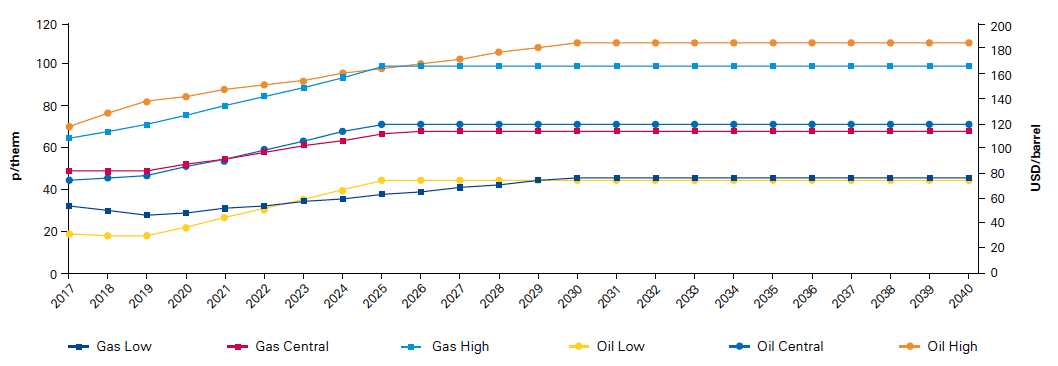
Source: DECC (2015)
Fossil fuel prices, especially oil, are sensitive to a number of factors including supply, elasticity of demand, weather, economic cycles and geopolitical events that may cause market uncertainty. Government (formerly DECC, now BIES going forward) publishes fossil fuel price projections on an annual basis.
We have used 2015 DECC low oil and gas wholesale fossil fuel price assumptions in modeling our three scenarios. It should be noted that there is considerable uncertainty as of how fossil fuel prices may change in the future. In Section 5.8 we use DECC high and central price projections to quantify the economic impacts to the Scottish economy should fossil fuel prices increase. For the purposes of this study NGLs are assumed to be sold at a discount to the oil price, in line with historical averages.
It is worth noting that given limited recoverable volumes, UK UOG outputs would only represent a fraction of the supply to the global market (House of Lords, 2014). Furthermore, the scale of development in Scotland will be much lower than that in the US and hence Scottish UOG is unlikely to have an impact on global energy prices. This implies that there may be substitution between gas sources rather than gas for other sources of energy. This is consistent with the CCC workstream in that overall usage of hydrocarbons is unchanged [26] .
4.5 Comparison of scenarios
We have assumed production volumes based on a number of pads because in the Midland Valley (a relatively densely populated area of Scotland) there are limits to the available space that can be used for UOG resource development. A 'developable' area is limited by urbanisation, faulting, water bodies, designated areas, etc. which limit the number of potential pad developments. We estimate that 20 pads could be developed in the Central scenario, while 31 and 10 could be developed in the High and Low scenarios respectively. Additionally, we assume that two CBM pads are developed in each scenario.
The unit costs of production from our scenarios at c45p/therm in the Central and Low scenarios (the Central and Low scenario have similar unit costs due to different cost assumptions) and 35 p/therm in the High scenario demonstrate that in a persistently low price environment the economics of development are likely to be marginal. It should be noted that there is considerable uncertainty as of how fossil fuel prices may change in the future. Fossil fuel price fluctuations would have an impact on the economic contribution of UOG for Scotland (see Section 5.8 for more details) as well as on the operators' financial standing.
The study published by EY in 2014 on shale gas provides a breakdown of the costs of hydraulic fracturing, drilling and completions, waste disposal and storage and transportation. These costs were for a hypothetical pad of 10 vertical wells with four laterals each (total of 40 laterals). In this study, we used the costs provided in the EY study and scaled them in accordance with the number of wells assumed in each scenario.
Table 4.1 provides a summary of the key parameters of each scenario. A detailed breakdown of costs is provided in Appendix C. The Institute of Directors (2013) study used a scenarios-based approach to demonstrate what the industry may look like in terms of production capacity and cost profiles. The study provides a breakdown of costs and production profiles for a smaller pad of 10 wells of one lateral each (10 laterals in total) and a larger pad of 10 wells of four laterals each (40 laterals in total). The authors of the study assume that for the smaller pad, expected gas production could reach 31.6 bcf over lifespan - our Low scenario assumes the same production output. Unlike this study, the study assumes that a 10 well pad costs £142 million while we estimate that this could cost £153 million (capex and opex) plus £5.5 million of decommissioning costs.
For the larger pad, the IoD study assumed that production could reach 126.2 bcf over lifespan (40 laterals), with investment of £514 million of investment. This is not directly comparable to our Central or High scenarios. In addition to the single pad cases presented in the IoD study, the authors provide an illustrative example of what widespread development could look like in the UK. This widespread development scenario assumes that shale gas production could reach commercial scale and that a hypothetical development of 100 pads of 10 wells of four laterals each ( i.e. a total of 4,000 laterals) could produce between 853 bcf and 1,389 bcf per annum at peak, based on the Institute of Directors (2013) sensitivity analysis.
Other studies such as the ones by Amion Consulting on the potential economic impacts of shale gas in the Ocean Gateway (2014) and the Bowland shale (2015), used a number of assumptions from the IoD (2013) study. For example, the authors assessed that for the Ocean Gateway area, a development of 30 shale gas production sites of 10 wells of four laterals each could be envisaged. This is similar to our High scenario in terms of number of pads but more optimistic in terms of total number of wells (vertical and horizontal).
Table 4.1 Summary of key parameters of each scenario.
| Product | Units | Central | High | Low | ||
|---|---|---|---|---|---|---|
| What could be produced | Shale gas | Cumulative output by 2062 | bcf | 947 | 2,934 | 316 |
| Lifetime production per pad | bcf | 47.3 | 94.7 | 31.6 | ||
| Associated liquids | Cumulative output by 2062 | MMBOE | 17.8 | 49.7 | 0.5 | |
| Lifetime production per pad | MMBOE | 1.2 | 2.4 | 0.1 | ||
| CBM | Cumulative output by 2062 | bcf | 26.3 | 26.3 | 26.3 | |
| Lifetime production per pad | bcf | 13.1 | 13.1 | 13.1 | ||
| How much would be produced (development approach) | Shale gas | Number of pads | No. | 20 | 31 | 10 |
| Wells per pad | No. | 15 | 30 | 10 | ||
| Production life of a well | Years | 15 | 15 | 15 | ||
| Associated liquids | Number of shale gas pads also producing associated liquids | No. | 15 | 23 | 8 | |
| Wells per pad | No. | 15 | 30 | 10 | ||
| Production life of a well | Years | 15 | 15 | 15 | ||
| CBM | Number of pads | No. | 2 | 2 | 2 | |
| Wells per pad | No. | 15 | 15 | 15 | ||
| Production life of a well | Years | 12 | 12 | 12 | ||
| How much would it cost | Shale gas and associated liquids | Capex [27] | £bn | 3.0 | 7.2 | 1.0 |
| Opex | £bn | 1.3 | 3.2 | 0.4 | ||
| Decommissioning | £bn | 0.1 | 0.4 | 0.1 | ||
| Expenditure within Scotland | £bn | 2.2 | 6.5 | 0.5 | ||
| CBM | Capex [28] | £bn | 0.3 | 0.3 | 0.3 | |
| Opex | £bn | 0.1 | 0.1 | 0.1 | ||
| Decommissioning | £bn | ~0.0 | ~0.0 | ~0.0 | ||
| Expenditure within Scotland | £bn | 0.2 | 0.2 | 0.2 | ||
| Community benefits payments and taxation | Shale gas and associated liquids and CBM | Community benefit payments | % of revenue | 4% | 4% | 4% |
| Taxation assumptions | Direct taxes: corporate tax payable on taxable company profits. Income tax and National Insurance contributions on salaries. | |||||
| Indirect VAT assumed recoverable on purchases with supply chain but levied on wholesale product sales. Local government: business rates charged on a per pad basis. | ||||||
| Estimated FTE employment per pad | Shale gas and associated liquids | Number of FTE jobs [29] | FTE | 80 | 90 | 55 |
| CBM | Number of FTE jobs [30] | FTE | - | - | - | |
| Estimated timing | Planning and licensing | years | 3 | 2 | 5 | |
| Exploration | years | 2 | 2 | 3 | ||
| Development | years | 1 | 1 | 2 | ||
| Production | years | 15 | 15 | 15 | ||
| Decommissioning | years | 3 | 2 | 5 | ||
| Aftercare | years | 20 | 20 | 20 | ||
Figure 4.2 shows the overall pad development profile in terms of the number of pads starting production in each year.
Total annual gas consumption in Scotland (2014) is estimated at 164 bcf/year (94 bcf/year for domestic sector and 70 bcf/year for non-domestic [31] ) (The Scottish Government, 2015). As a point of comparison, a total production of 947 bcf of gas in our Central scenario represents about 5.5 years of Scottish consumption. In our High scenario (2,934 bcf) this represents about 18 years of Scottish consumption.
Figure 4.2 Pad development profiles by scenario.
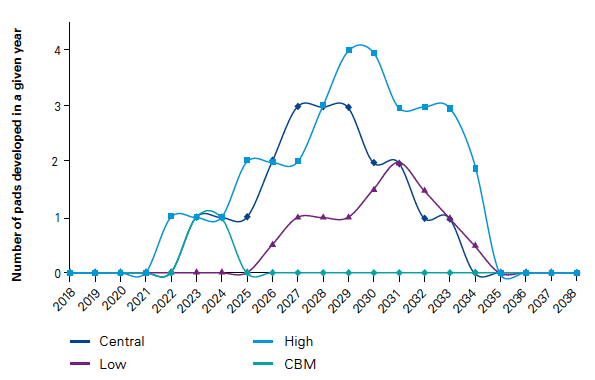
Figure 4.3 Shale gas total annual output.
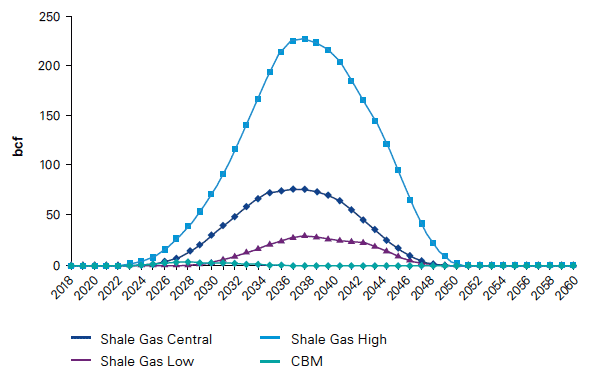
Figure 4.4 Shale gas total cumulative output.
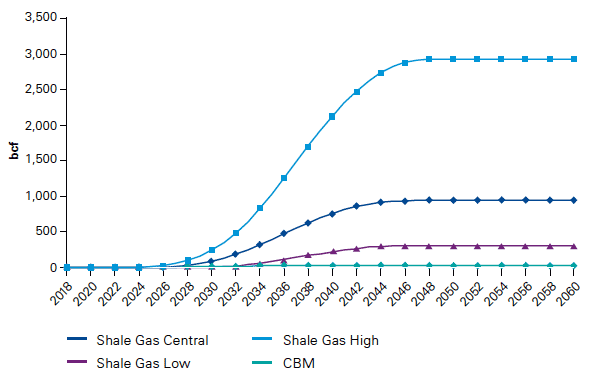
Figure 4.5 Associated liquids total annual output.
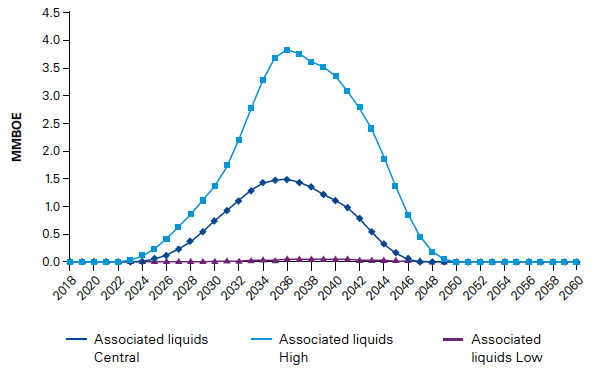
Figure 4.6 Associated liquids total cumulative output.
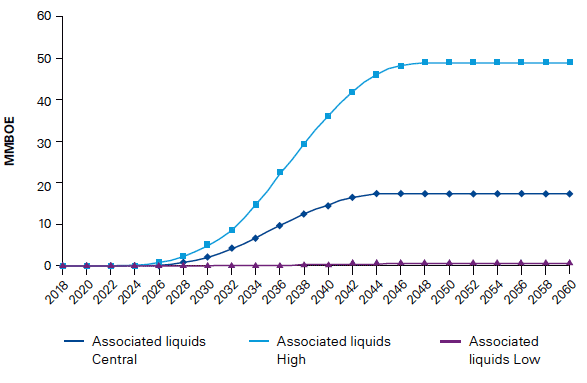
Contact
There is a problem
Thanks for your feedback